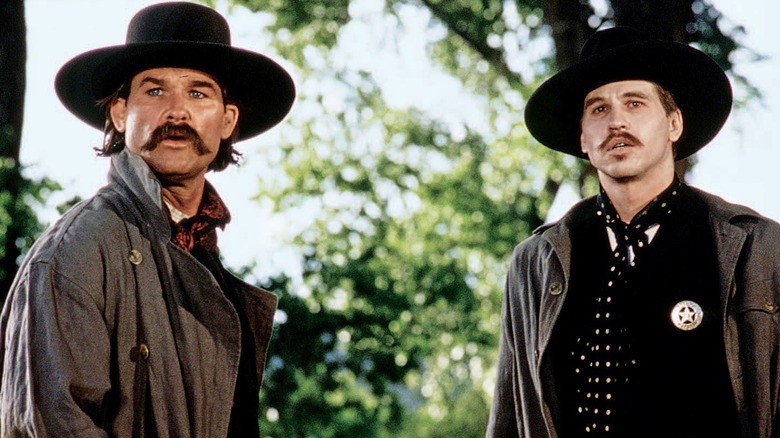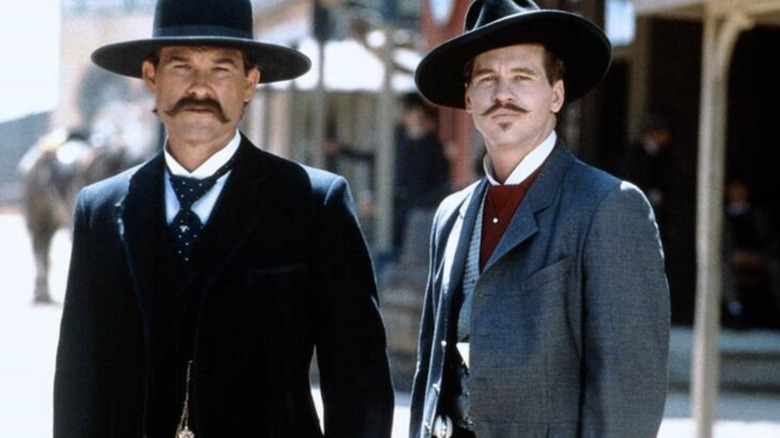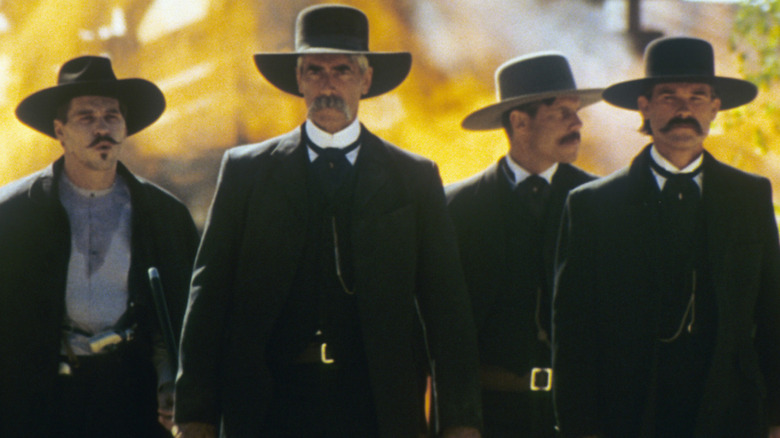
If you’ve seen 1993’s “Tombstone,” you know that it contains one of the greatest visual effects ever seen in a Western. No, it’s not the movie’s explosive gunfights, nor is it the shots featuring teams of horses being ridden over precarious terrain. Instead, it’s the fabulously outlandish, hirsute, and downright masculine mustaches that almost every single male actor in the movie sports. “Tombstone” is a movie about capital-D Dudes, and the actors’ mustache game is so strong that it has the power to change lives. Take me, for instance; I was primarily a Beard Guy for many years, but upon revisiting “Tombstone” over the holiday season of 2023, I made the decision to become a Mustache Man, and I’ve yet to look back.
It just so happens that the power and influence of the mustaches in “Tombstone” was 100% intentional. No incidental or idle hair and makeup styling was happening on that set, as the film’s truly stacked roster of actors — including star (and ersatz director) Kurt Russell, Val Kilmer, Sam Elliott, Bill Paxton, and Charlton Heston — were putting the work in on their facial hair to get it to look not just period accurate but as powerful as possible. According to a 2010 interview with Michael Biehn, who portrays the educated psychopath gunslinger Johnny Ringo in the film, the actors had to follow a strict mustache maintenance rule to keep their ‘staches. Not only did this rule encourage the actors to grow their own mustaches, but it also allowed their real facial hair to double as a bit of a status symbol, leaving at least one actor who was forced to use a fake ‘stache to feel left out.
For the mustaches in ‘Tombstone,’ it’s all in the curl
As Biehn explained to Movieweb in 2010, the mustache maintenance mandate originated from the original director (and still credited writer) of “Tombstone,” Kevin Jarre. According to Biehn, it wasn’t so much that Jarre insisted that all the men grow a mustache, just that if they chose to, they had to follow his particular rule:
“Everyone just grew a mustache. When it comes down to it, this goes back to Kevin Jarre, the film’s original director. He was very specific about how he wanted the mustaches. He wanted them to curl up on the end. Which means, if you grow a mustache, and it grows long enough, you have to use wax on the end of it.”
Biehn was quick to point out that the vibe on the set “wasn’t like a mustache styling competition,” but seemed to imply that Jarre’s rule only served to encourage the actors to grow their own mustaches as big and as long as they could to try and adhere to the director’s preference. While this may not have instigated an actual competition between the actors, it did leave one actor feeling inadequate for having to don a fake ‘stache, as Biehn explains:
“Everyone was pretty proud that they grew their own mustache. There was one guy, Jon Tenney. He didn’t get to grow his own mustache because he had a job right before that. They had to put a fake mustache on him. I think he always felt a little bit like the small dog of the group. Because it wasn’t his real mustache. He had to take his mustache off everyday.”
Tenney’s character of Sheriff Johnny Behan eventually becomes one of the villains of the film, so at least he was able to sublimate this “small dog” feeling into his character, those emotions giving the Sheriff some extra menace and resentment toward Wyatt Earp (Russell) and his prideful brothers.
‘Tombstone’ is a fascinating slice of machismo, hence the mustaches
Naturally, most discussions of “Tombstone” have to bring up the film’s troubled production, as Biehn alluded to in his comments. It turns out that the mustache mandate was far from the only rule that Jarre had on set while he was still directing the film, leading to tension between himself, the leading actors, the crew, and the producers, all of which led to his eventual firing. Biehn tried to explain the issues all stemmed from Jarre being too rigid in his creative choices:
“It was sad for me. I liked Kevin a lot. He was the one that wrote the script. He really wanted that script to be the way he wanted it to be. He wanted to cast it the way he wanted to cast it. He wanted the saddles to look the way he wanted them to look. He wanted the spurs to be a certain way. He wanted the mustaches to be a certain way. He wanted the dialogue to be a certain way. He wanted it shot in a certain way. He wanted everything exactly the way he wanted it. And, you know? The filmmaking business is a little more collaborative than that.”
The controversy doesn’t end there, of course, as it’s long been implied that Jarre’s replacement, George P. Cosmatos, was hired to essentially cover for star Russell taking over the directing reins, despite Cosmatos preparing a director’s cut of the film (complete with commentary track) in 2002. Whatever the ownership of “Tombstone” is, there’s no denying that Jarre’s influence remains in it — the movie fits right in with the screenwriter’s penchant for stories about men having to confront and/or display their machismo when challenged by extreme circumstances.
In fact, it’s thanks to Jarre’s work that the film remains as popular and indelible as it is. His signature themes of men wrestling with their own egos, their responsibilities, and their pride are suffused throughout “Tombstone.” When that’s coupled with the movie’s oh-so-quotable tough-guy dialogue and, yes, those magic mustaches, “Tombstone” is exactly the kind of movie that can — ahem — really grow on you.




Leave a Reply